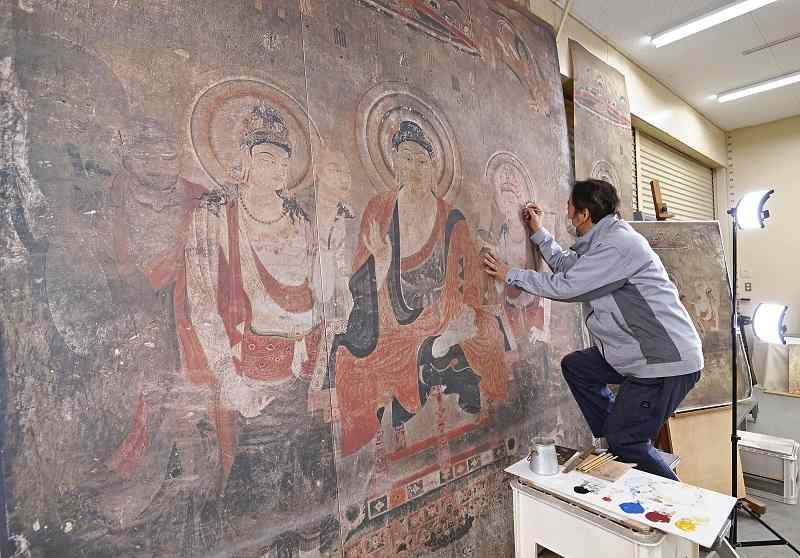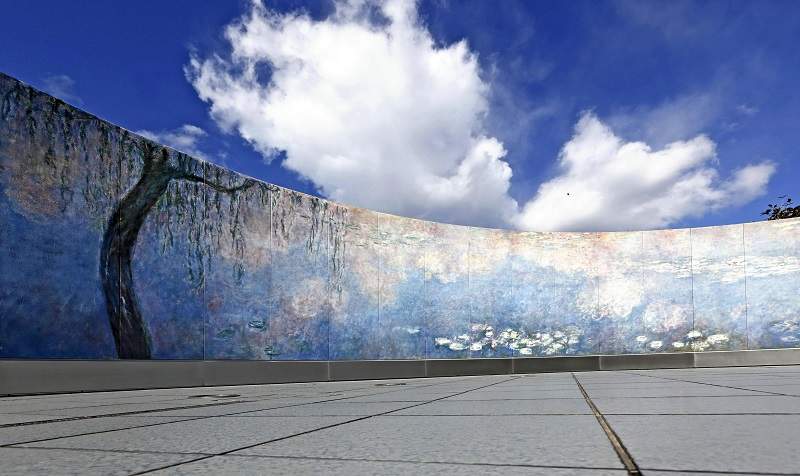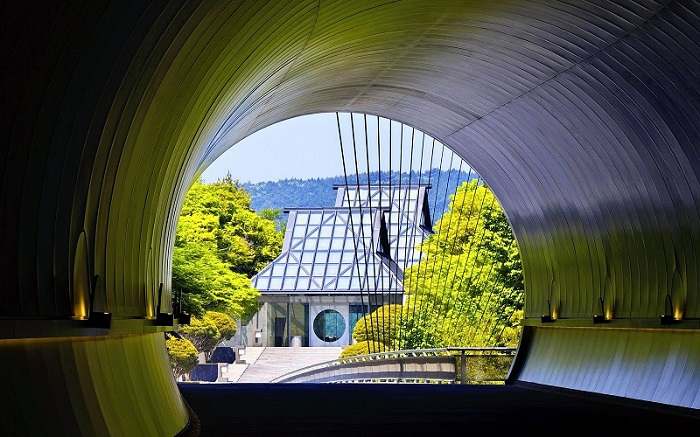
A wall painting from the main hall of Horyuji temple is reproduced at the Shigaraki plant of Otsuka Ohmi Ceramics Co. in Koka, Shiga Prefecture.
12:11 JST, April 23, 2022
KOKA, Shiga — A factory in Shiga Prefecture is using the durability of ceramics to reproduce important cultural assets, helping the originals to be appreciated by more people and handing down exquisite copies to future generations.
The Shigaraki plant of Otsuka Ohmi Ceramics Co. reproduces valuable wall paintings from ancient Japan on ceramic panels, in the same size as the original artwork. It also re-creates overseas masterpieces by such artists as Picasso and Michelangelo.
The plant is located in Koka City’s Shigaraki district, noted for its earthenware pottery.
Same-size panels
Staff at the Shigaraki plant have recently been reproducing Buddhist murals from Horyuji temple in Nara Prefecture, which was founded in the seventh century and is famous for beiing the world’s oldest surviving wooden structure. The original paintings on the walls of the temple’s main hall were destroyed in a fire in 1949. The plant has been working for three months, since December last year, to reproduce them on ceramic panels.
“Ceramic works will remain almost intact for future generations, so we feel a great responsibility,” Hideharu Matsubara said with a smile. The 64-year-old is in charge of adding finishing touches to the paintings.
The ceramic panel paintings are created through a combination of cutting-edge computer technology and meticulous manual labor.
Each ceramic panel is made from clay stretched into a sheet and fired for eight to 10 hours in a kiln at a maximum temperature of about 1,200 C. Colors of the artwork to be reproduced are printed onto the ceramic panel via special transfer paper, which is created by the inputting image data of the original artwork.
After applying and baking the original color onto the panel, artisans make subtle color adjustments with a brush, and then fire the panel again.
Otsuka Ohmi Ceramics was asked by the Nara prefectural government to reproduce one of the Horyuji temple murals, “The Pure Land of Shaka” from Wall No. 1. Shaka refers to Buddha, the founder of Buddhism. The staff made revision after revision based on the opinions of experts.
The resulting panel is about 3.1 meters high, 2.6 meters wide and 4 centimeters thick. It comprises three ceramic plates, on which the Buddha, Bodhisattva and other figures are depicted.
After being exhibited in China, the panel is scheduled to go on display at the museum at the Archaeological Institute of Kashihara in Nara Prefecture.
The Shigaraki plant has also reproduced other famous murals. The Takamatsuzuka Tumulus, an ancient burial mound in the village of Asuka, Nara Prefecture, is believed to have been built in the early eighth century, and is treasured for its brilliantly colored murals. The Shigaraki plant was involved in reproducing the murals, including the most famous painting, which depicts a group of women, and is known as the “Asuka Beauties.”
The brilliant colors and original textures of the paintings were reproduced exactly as they were when discovered 50 years ago, utilizing newly acquired 3D data.
The plant has a showroom that drew many visitors in tourist buses from 2019 to early 2020, thanks to a TV drama set in the Shigaraki district. The showroom has been closed to visitors due to the spread of the novel coronavirus, but Otsuka Ohmi Ceramics will consider reopening it once the pandemic is under control.
Masterpieces of art
Otsuka Ohmi Ceramics is a member of the Otsuka Group, known for its Otsuka Pharmaceutical Co., which was founded in Naruto, Tokushima Prefecture.

Monet’s “Water Lilies” reproduced on ceramic panels at Otsuka Museum of Art in Naruto, Tokuhima Prefecture
When fellow member company Otsuka Chemical Co. expanded its business into manufacturing tiles for building materials, the new business division was merged with a ceramics company in Shiga Prefecture to form the current company in the summer of 1973.
Shortly after the first oil crisis erupted that year, Otsuka Ohmi Ceramics switched to the business of reproducing artwork on large ceramic panels.
The company has been praised for its technical skills in firing large ceramic plates without distortion and using glazes in about 20,000 colors, which has helped pass on exceptional copies of cultural assets.
In 2010, the company was commissioned by the Cultural Affairs Agency to reproduce murals at another ancient tomb in the village of Asuka. The Kitora Tomb is believed to have built from the late seventh century to the early eighth century and is also important for the colored drawings in its stone chamber. The company re-created the drawings on the ceiling and the four walls using its ceramic panels.
The Otsuka Museum of Art in Naruto is exhibiting more than 1,000 replicas made by Otsuka Ohmi Ceramics of famous paintings by Monet, Picasso and other great artists.
The museum opened in 1998 to commemorate the 75th anniversary of the founding of the Otsuka Group, and has welcomed many visitors from Japan and abroad. It has proved popular as an art museum where you can enjoy copies of masterpieces from around the world. About 6 million tourists have so far visited the facility.
Ceramic panels will last for more than 2,000 years unless cracked.
“Ceramic panels are resistant to changes in temperature and humidity. You can feel the textures by touching them and see them outdoors even on rainy days. I hope people will appreciate the panels in various settings,” said Eitsugu Osugi, 66, president of Otsuka Ohmi Ceramics.

Miho Museum is seen through a tunnel.
Extend your trip! : Miho Museum
Opened in 1997, this museum has a collection of about 3,000 antiques and other artifacts from Japan and abroad. It was built on the other side of a suspension bridge at the end of a tunnel. An exhibition featuring tea ceremony utensil masterpieces and other related items is currently being held. The spring season runs through June 5, and the summer season from July 9 to Aug. 14. Reservations are required for admission.

How to get there
The nearest station to Otsuka Ohmi Ceramics’ Shigaraki plant is Shigaraki Station on the Shigaraki Kogen Railway. Showroom tours are temporarily suspended due to the spread of the novel coronavirus. The head office is in Osaka City. Miho Museum is located at Ishiyama Station on the JR Tokaido Line. It takes about 50 minutes to get to the museum by bus. By car, it takes about 15 minutes from the Shigaraki Interchange on the Shin-Meishin Expressway.
Related Tags
"Features" POPULAR ARTICLE
-

Sanrio to Open Museum in Yamanashi Pref. Dedicated to Founder, Exhibits Include Hello Kitty, Other Characters
-

Autumn Foliage Surrounds Visitors to Tokyo’s Showa Kinen Park
-

My Daughter No Longer Speaks to Me, But I Want to See Her and My Grandchild
-

Kumamoto: Public Bath Refurbished as Library Where You Can Chat, Take Photos
-

Frozen Vegetables: Demand Rises for Convenient, Tasty Domestic Produce
JN ACCESS RANKING
-

Keidanren Chairman Yoshinobu Tsutsui Visits Kashiwazaki-Kariwa Nuclear Power Plant; Inspects New Emergency Safety System
-

Imports of Rare Earths from China Facing Delays, May Be Caused by Deterioration of Japan-China Relations
-

Tokyo Economic Security Forum to Hold Inaugural Meeting Amid Tense Global Environment
-

University of Tokyo Professor Discusses Japanese Economic Security in Interview Ahead of Forum
-

Japan Pulls out of Vietnam Nuclear Project, Complicating Hanoi’s Power Plans


























